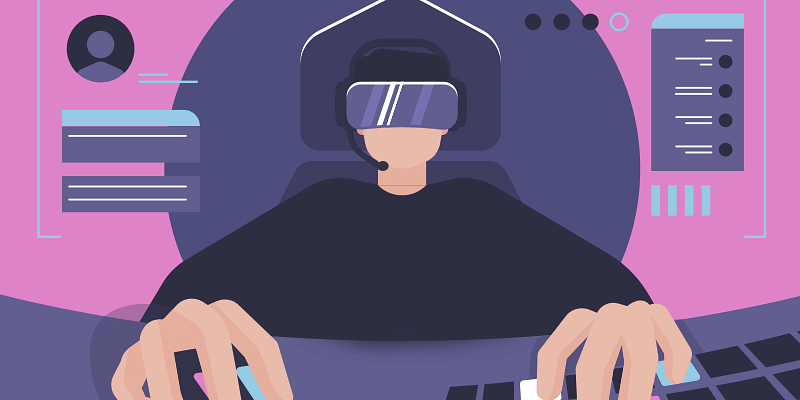
The gaming industry has never shied away from adopting innovations and technologies. Being one of the first industries to adopt AI in the 1950s, the gaming industry has grown from arcade console gaming to multiplayer gaming on the cloud, elevating the player experience to new heights. Now, with major developments in the AI space, video game companies are dipping their toes into the rapidly evolving world of generative AI.
With the ability to produce high-quality content like synthetic data, audio, video, text, and imagery, generative AI is revolutionising the gaming industry. From making captivating characters and game assets to creating 3D worlds with a single prompt, generative AI offers players limitless gameplay possibilities. The technology has opened up new frontiers for players, like endless open worlds, unique content, autonomous characters, and the potential for faster game development.
Reports suggest generative AI in the gaming market is expected to be worth around $7,105.4 million by 2032 from $922 million in 2022, growing at a CAGR of 23.3%.
Let’s explore how generative AI is impacting the game development process and transforming gaming as we know it today.
Procedural Content Generation (PCG)
Procedural Content Generation is a popular game development technique that harnesses the power of generative AI. It involves algorithmically creating game content, such as landscapes, levels, assets, and quests, without the hassle of manual design. The technology leverages AI algorithms to generate content dynamically, ensuring that no player’s gameplay experiences are alike and, hence, providing infinite content diversity. With PCG, developers can deliver endless ‘replayability’ for their games, reduce development time, and lower production costs.
Going forward, these algorithms can be used to create new ways to play games and design and develop other gaming elements while offering each gamer a more unique and personalised experience.
Enhance non-player characters’ behaviour
The concept of non-player character (NPC) has been a crucial game element since the early days. And now, with the integration of generative AI, we are witnessing a significant shift in NPCs, making them more realistic and lifelike than ever before. They now have conversations, react to the player’s actions, and serve as key characters within the game’s narrative, creating dynamic experiences for players. By analysing players’ behaviour, developers can create NPCs that offer unparalleled realism, adaptability, and emotional depth, elevating the gaming experience. Today, NPC can even collaborate with players to accomplish in-game tasks, allowing players to take a central role in the game.

.thumbnailWrapper{
width:6.62rem !important;
}
.alsoReadTitleImage{
min-width: 81px !important;
min-height: 81px !important;
}
.alsoReadMainTitleText{
font-size: 14px !important;
line-height: 20px !important;
}
.alsoReadHeadText{
font-size: 24px !important;
line-height: 20px !important;
}
}

Content personalisation
For a long time, the industry was dominated by level-oriented single-player games that deliver identical gaming experiences to all players alike. While single-player games are still going strong, gamers’ appetite for more customised gaming has increased significantly. Generative AI is effectively addressing this demand.
With the ability to tailor games according to player behaviours, generative AI allows developers to analyse and understand each player’s preferences. It can create stories, quests, and character interactions customised to each player’s journey, enhancing missions and rewards per their preferences. This level of personalisation offers deep player immersion as games dynamically interact with their actions and choices. It also personalises the game as per the players’ skill and gaming style, keeping them hooked for longer. Whether it’s generating unique levels based on player preferences or customising in-game items to match different playstyles, generative AI enhances player satisfaction and engagement.
Visual enhancements
The whole idea of a good game is to create an immersive and challenging experience for players that keeps them entertained for a long time and helps them escape reality. And the primary thing that engages any gamer are game graphics and visuals. The better the visuals, the more involved the players will be.
Generative AI allows developers to generate realistic graphics more quickly and accurately based on an AI database. It is simpler to add textures, animations and more human expressions in characters deploying the generative AI tools. Developers can integrate tools like generative AI-driven upscaling, ray tracing, and denoising techniques to amp up the process. In the coming years, generative AI will produce high-fidelity textures and realistic visual effects that closely mirror the real world, ensuring a gaming world that is visually appealing and deeply immersive.
.thumbnailWrapper{
width:6.62rem !important;
}
.alsoReadTitleImage{
min-width: 81px !important;
min-height: 81px !important;
}
.alsoReadMainTitleText{
font-size: 14px !important;
line-height: 20px !important;
}
.alsoReadHeadText{
font-size: 24px !important;
line-height: 20px !important;
}
}

Boosts the development process
Typically, AAA game titles take about 2-5 years of production time to develop and roll out the game. The task involves exhaustive work of storyboarding, design, coding, music, production, marketing, etc, which requires a lot of effort, talent and cost.
Generative AI stands out as a game-changer in this area as it revolutionises designs and paves the way for a new era of gaming. The technology allows developers to generate engaging storylines, build music, and create game levels, maps, landscapes, art, and graphics.
Coupled with machine learning algorithms, generative AI tools can analyse real-time data, identify players’ patterns, and suggest an interactive gameplay design. By cutting down on manual work, generative AI can help accelerate game production and save costs. Bolstering the gaming process with generative AI tools can also create unique and creative game genres like never before. This efficiency allows developers to complete the gaming process swiftly and focus on more creative and strategic aspects of the development process.
Game testing and bug detection
Lastly, it’s always essential to keep a check on glitches and lags before the game is launched. With the help of generative AI tools, it becomes handy to identify bugs in real-time. AI algorithms intend to improve decision-making, test game mechanics, and assess player behaviour, among other things. This increases the efficiency of the testing process and ensures a higher level of accuracy in identifying potential issues. It helps game developers save time and fix problems more quickly and efficiently. Once the game’s testing is done, it tells the developers whether or not the game is ready to be put up on the market.
The gaming industry has embraced generative AI with open arms. It is making games faster, more realistic, and more immersive, opening up new possibilities for game development. In the near future, generative AI will unlock creativity and innovation, ensuring gaming is filled with thrilling adventure.
(Abhik Saha is the CTO and Co-founder of OnePlay.)
Edited by Kanishk Singh


![Read more about the article [Funding alert] FMCG distribution platform Dropshop raises Rs 9.3 Cr in pre-Series A led by Inflection Point Ventures](https://blog.digitalsevaa.com/wp-content/uploads/2021/06/Imageao1e-1623651077416-300x150.jpg)


![Read more about the article [Funding alert] Delhi startup Marquee Equity secures $3.8M from Capital One, Arrowroot Capital, others, for un](https://blog.digitalsevaa.com/wp-content/uploads/2021/02/165-VC-funding1552277843560-300x150.jpg)




